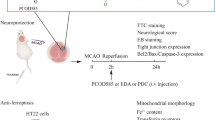Summary
Poly (ADP-ribose) polymerase-1 (PARP-1) plays as a double edged sword in cerebral ischemia-reperfusion, hinging on its effect on the intracellular energy storage and injury severity, and the prognosis has relationship with intervention timing. During ischemia injury, apoptosis and oncosis are the two main cell death pathway sin the ischemic core. The participation of astrocytes in ischemia-reperfusion induced cell death has triggered more and more attention. Here, we examined the protective effects and intervention timing of the PARP-1 inhibitor PJ34, by using a mixed oxygen-glucose deprivation/reperfusion (OGDR) model of primary rat astrocytes in vitro, which could mimic the ischemia-reperfusion damage in the “ischemic core”. Meanwhile, cell death pathways of various PJ34 treated astrocytes were also investigated. Our results showed that PJ34 incubation (10 μmol/L) did not affect release of lactate dehydrogenase (LDH) from astrocytes and cell viability or survival 1 h after OGDR. Interestingly, after 3 or 5 h OGDR, PJ34 significantly reduced LDH release and percentage of PI-positive cells and increased cell viability, and simultaneously increased the caspase-dependent apoptotic rate. The intervention timing study demonstrated that an earlier and longer PJ34 intervention during reperfusion was associated with more apparent protective effects. In conclusion, earlier and longer PJ34 intervention provides remarkable protective effects for astrocytes in the “ischaemic core” mainly by reducing oncosis of the astrocytes, especially following serious OGDR damage.
Similar content being viewed by others
References
Eliasson MJ, Sampei K, Mandir AS, et al. Poly (ADP-ribose) polymerase gene disruption renders mice resistant to cerebral ischemia. Nat Med, 1997,3(10):1089–1095
Jagtap P, Szabó C. Poly (ADP-ribose) polymerase and the therapeutic effects of its inhibitors. Nat Rev Drug Discov, 2005,4(5):421–440
Juurlink BH, Hertz L, Yager JY. Astrocyte maturation and susceptibility to ischaemia or substrate deprivation. Neuroreport, 1992,3(12):1135–1137
Salvesen GS. Caspases: opening the boxes and interpreting the arrows. Cell Death Differ, 2002,9(1):3
Ghavami S, Hashemi M, Ande SR, et al. Apoptosis and cancer: mutations within caspase genes. J Med Genet, 2009,46(8):497–510
Huang Q, Zhang R, Zou L, et al. Cell death pathways in astrocytes with a modified model of oxygen-glucose deprivation. PLoS ONE, 2013,8(4):e61345
Montgomery DL. Astrocytes: form, functions, and roles in disease. Vet Pathol, 1994,31(2):145–167
Benjelloun N, Joly LM, Palmier B, et al. Apoptotic mitochondrial pathway in neurones and astrocytes after neonatal hypoxia-ischaemia in the ratbrain. Neuropath Appl Neuro, 2003,29(4):350–360
Giffard RG, Swanson RA. Ischemia-induced programmed cell death in astrocytes. Glia, 2005,50(4):299–306
Giffard RG, Xu L, Zhao H, et al. Chaperones, protein aggregation, and brain protection from hypoxic/ischemic injury. J Exp Biol, 2004,207(18):3213–3220
Takuma K, Baba A, Matsuda T. Astrocyte apoptosis: implications for neuroprotection. Prog Neurobiol, 2004,72(2):111–127
Chu X, Fu X, Zou L, et al. Oncosis, the possible cell death pathway in astrocytes after focal cerebral ischemia. Brain Res, 2007,1149:157–164
Cao X, Zhang Y, Zou L, et al. Persistent oxygen-glucose deprivation induces astrocytic death through two different pathways and calpain-mediated proteolysis of cytoskeletal proteins during astrocytic oncosis. Neurosci Lett, 2010,479(2):118–122
Zhang R, Huang Q, Zou L, et al. Beneficial effects of deferoxamine against astrocyte death induced by modified oxygen glucose deprivation. Brain Res, 2014,1583:23–33
Kern JC, Kehrer JP. Acrolein-induced cell death: a caspase-influenced decision between apoptosis and oncosis/necrosis. Chem Biol Interact, 2002,139(1):79–95
Del Nagro C, Xiao Y, Rangell L, et al. Depletion of the central metabolite NAD leads to oncosis-mediated cell death. J Biol Chem, 2014,289(51):35182–35192
Abdelkarim GE, Gertz K, Harms C, et al. Protective effects of P34, a novel, potent inhibitor of poly (ADP-ribose) polymerase (PARP) in in vitro and in vivo models of stroke. Int J Mol Med, 2001,7:255–260
Nagayama T, Simon RP, Chen D, et al. Activation of poly (ADP-ribose) polymerase in the rat hippocampus may contribute to cellular recovery following sublethal transient global ischemia. J Neurochem, 2000,74(4):1636–1645
Zakeri Z, Bursch W, Tenniswood M, et al. Cell death: programmed, apoptosis, necrosis, or other? Cell Death Differ, 1995,2(2):87–96
Sayk F, Bartels C. Oncosis rather than apoptosis? Ann Thorac Surg, 2004,77(1):382; author reply 382–383
Jugdutt BI, Idikio HA. Apoptosis and oncosis in acute coronary syndromes: assessment and implications. Mol Cell Biochem, 2005,270(1–2):177–200
Weerasinghe P, Buja LM. Oncosis: an important non-apoptotic mode of cell death. Exp Mol Pathol, 2012,93(3):302–308
Walisser JA, Thies RL. Poly (ADP-ribose) polymerase inhibition in oxidant-stressed endothelial cells prevents oncosis and permits caspase activation and apoptosis. Exp Cell Res, 1999,251(2):401–413
Lieberthal W, Menza SA, Levine JS. Graded ATP depletion can cause necrosis or apoptosis of cultured mouse proximal tubular cells. Am J Physiol-renal, 1998,274(2):F315–F327
Schreiber V, Dantzer F, Ame J-C, et al. Poly (ADP-ribose): novel functions for an old molecule. Nat Rev Mol Cell Bio, 2006,7(7):517–528
Ma LS, Jiang CY, Cui M, et al. Fluopsin C induces oncosis of human breast adenocarcinoma cells. Acta Pharmacol Sin, 2013,34(8):1093–1100
Sun L, Zhao Y, Yuan H, et al. Solamargine, a steroidal alkaloid glycoside, induces oncosis in human K562 leukemia and squamous cell carcinoma KB cells. Cancer Chemother Pharmacol, 2011,67(4):813–821
Virág L, Robaszkiewicz A, Rodriguez-Vargas JM, et al. Poly (ADP-ribose) signaling in cell death. Mol Aspects Med, 2013,34(6):1153–1167
Stoica BA, Loane DJ, Zhao Z, et al. PARP-1 inhibition attenuates neuronal loss, microglia activation and neurological deficits after traumatic brain injury. J Neurotrauma, 2014,31(8):758–772
Hensley P, Mishra M, Kyprianou N. Targeting caspases in cancer therapeutics. Biol Chem, 2013,394(7):831–843
Wani WY, Sunkaria A, Sharma DR, et al. Caspase inhibition augments Dichlorvos-induced dopaminergic neuronal cell death by increasing ROS production and PARP1 activation. Neuroscience, 2014,258:1–15
Author information
Authors and Affiliations
Corresponding author
Additional information
The two authors contributed equally to this work.
This work was supported by the National Natural Science Foundation of China (No. 30971024).
Rights and permissions
About this article
Cite this article
Cai, C., Zhang, R., Huang, Qy. et al. Intervention timing and effect of PJ34 on astrocytes during oxygen-glucose deprivation/reperfusion and cell death pathways. J. Huazhong Univ. Sci. Technol. [Med. Sci.] 35, 397–404 (2015). https://doi.org/10.1007/s11596-015-1444-z
Received:
Revised:
Published:
Issue Date:
DOI: https://doi.org/10.1007/s11596-015-1444-z




